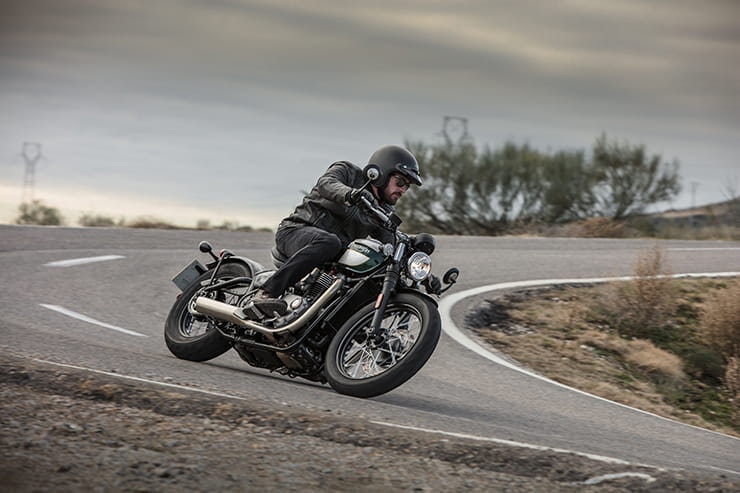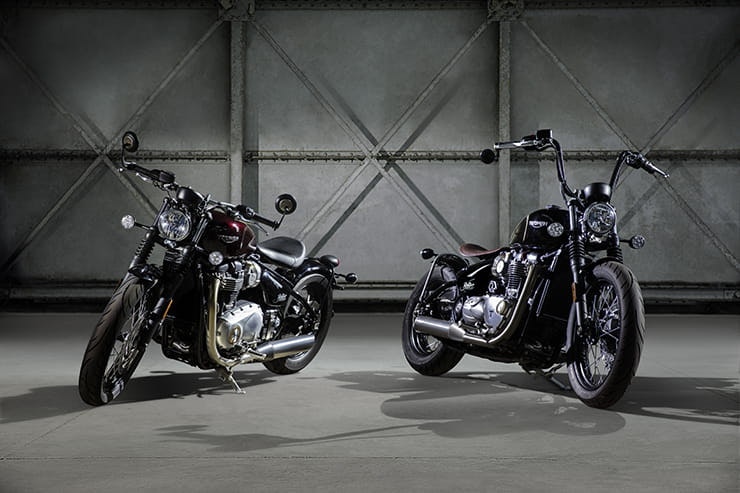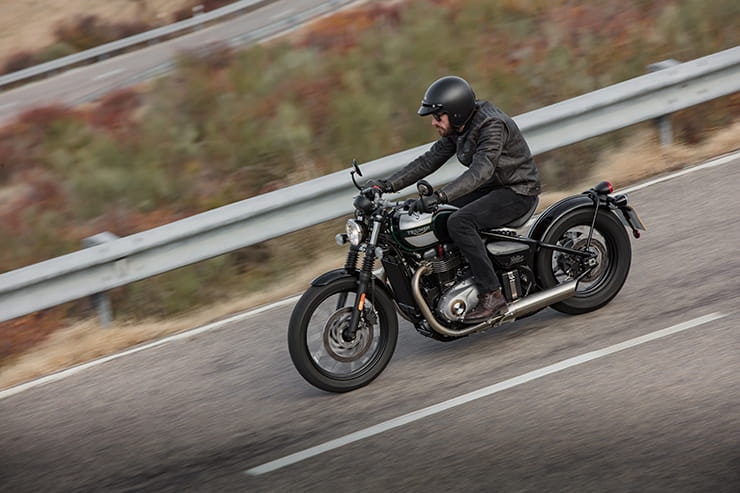Triumph Bonneville Bobber (2017 - 2020): Review & Buying Guide
By Jon Urry
Massively experienced road tester
24.11.2021
Taking inspiration from the post-war bikes of the 1940s when returning GIs ‘bobbed’, which basically means cut off, the back end of their motorcycles to create a stripped-down custom ‘bob-tail’ look, the Triumph Bonneville Bobber was launched in 2017. Amazingly styled, the Bobber is also fairly authentic with its front end and chassis borrowed from the firm’s Bonneville T120 models and its rear given a hardtail look. A truly breath-taking bike in the flesh (especially in the two-tone green and silver paint), the Bobber was a smash-hit for the firm and was one of Triumph’s fastest-selling models in 2017. Followed up by the Bobber Black in 2018, which uses a fat 16-inch front wheel rather than the Bobber’s skinny 19-inch item, the Bobber remained in the line-up until 2020 when it was discontinued and the Black became known just as the Bonneville Bobber. If you are after a bike to enjoy at the weekends (for short rides...) and possibly also lightly customise a bit here and there, the Bonneville Bobber is a cool choice that is fun to ride (briefly...) and extremely stylish. It’s not a Harley, but to many riders that’s no bad thing at all...
Triumph Bonneville Bobber (2017-2020) Price
The Bobber had an RRP of £10,500 in 2017, although that was only the black one, if you wanted one of the cooler colour schemes you had to fork out an extra £150 for red or ironstone or £300 for the amazing green and silver two-tone look. Nowadays the Bobber holds its value well with 2017 models changing hands for between £7500 and £8500 in a dealership with the green/silver still commanding a premium and being trickier to locate. There are very few sold privately, mainly down to buyers purchasing their bikes on PCP and therefore handling them back to the original dealer when the finance matures. If you want one of the last models, a 2020 bike will cost you in the region of £10,000 in a Triumph dealership.
Power and torque
The parallel twin HT (High Torque) engine is effectively the same as used in the T120 Bonneville models however it has been given a very slightly different ‘Bobber’ tune, mainly down to the new exhaust system and air intake. With a touch more low-end grunt (10% at 4500rpm) than the T120 the Bobber it feels that little bit more enthusiastic than the slightly lethargic Bonnie and is better fun to ride as a result. Still a very easy-going motor, you can just stick it in fifth (sixth is a bit too much like an overdrive for anything other than straight lines) and chill-out. With 70mph seeing the motor hardly ticking over at 3000rpm and next to no vibrations, life is very relaxed on the Bobber – well, in terms of the engine anyway...
Engine, gearbox and exhaust
The 1200 parallel twin was introduced on the T120 models in 2016 and it has a very solid reputation for reliability with even the more aggressive HP (High Power) and TFT (Triumph Factory Custom) bikes pushing its performance without sacrificing any reliability. Its clever old-school lookalike single overhead cam design means that even the major 20,000-mile service, which includes the valve-clearances, isn’t too expensive at £600 – not that any Bobbers will have hit this point. Triumph recommend the Bobber is serviced every year (oil, filters etc) at a cost of about £200 with the major every 10,000 miles (air and fuel filters, oil, plugs), which is a bigger bill of about £500. Technically the fuel lines should be swapped every four years as well as the coolant every three years and brake fluid every two. If it goes to an official Triumph dealer this will almost certainly be done (it is required if it is under a PCP deal) but if it goes to a non-official Triumph mechanic these things may well be skipped so check where it was taken by looking at the service book. Pleasingly, the Bobber’s exhaust is fully brushed stainless steel, so rust isn’t a worry, and the gearbox is also solid. Very few, if any, owners complain about the level of finish on the engine – probably as not many Bobbers get ridden in the wet or winter grime! Generally as long as it has a good service history (nearly all will) you are safe in terms of its motor.
Triumph Bonneville Bobber (2017-2020)) Economy
Triumph claimed the Bobber could deliver 69mpg, however as it only has a 9.1-litre tank that equates to a fairly limited range of just over 130 miles. Is this a problem? Not at all, after 100 miles the fuel light illuminates (sometimes before) and the seat is simply agony so you will be more than happy to see that warning showing on your dash, giving you an excuse to pull over and work some life back into your aching back/bum! Realistically, low 60mpg numbers are possible, mid 50s more realistic and some riders have even seen the warning light come on before even 70 miles have been covered. Although they may have made that up as an excuse to get off the bike...
Handling, suspension, chassis and weight
The Bobber may look like it won’t handle but looks can be deceiving and it is actually a lot of fun in the bends. Limited fun it has to be said as things start to scrape quite quickly (always check the exhausts for marks when buying used) but fun nonetheless. Tipping the scales at 228kg dry (Triumph refuse to quote wet weights, add about 10kg) the Bobber’s low centre of gravity and good natural balance see it roll reassuringly into corners with the Avon Cobra tyres delivering impressive amounts of feedback and more than enough grip. The 19-inch front wheel takes a bit of getting used to (the 16-inch Black does feel far sportier) but put the effort in and the Bobber responds with gusto. However it’s not all good news and while the forks are acceptable in their performance (they lack any adjustment) the shock is fairly horrible. In order to give the Bobber a ‘chopped’ rear end, the shock is fairly short and that means when you hit a big bump in the road it doesn’t have enough damping to absorb the shock, meaning it is up to your back and bum to do the job. If the seat had a bit of padding this wouldn’t be such an issue, but sadly it doesn’t and therefore the ride quality is harsh over uneven surfaces or poorly tarmacked roads. At low speed and through a city the suspension works fine and the Bobber is fairly easy-going, up the pace and it can get painful. When buying used, always have a good look at the spokes for any signs of rust (unlikely) and also the hero blobs for scrapes (and the exhausts).
Triumph Bonneville Bobber (2017-2020) Brakes
One word – lacking! Despite its weight the Bobber only gets a single two-piston sliding caliper out front with a single-piston on the rear (the Black gets two discs). Although the ABS system is good, you do need to use both brakes to halt the fairly hefty Bobber in a quick fashion so get used to this if you usually only rely on the front!
Comfort over distance and touring
Cleverly, Triumph designed the Bobber’s single seat (no pillion here, buy the Speedmaster for that kind of activity) to be able to slide back and forth, adjusting the riding position. Does it help with comfort levels Not at all, it is still horribly uncomfortable due to the suspension. It’s most certainly not a bike for touring as not only will it batter your back, it has next to no tank range and even less weather protection. If you want to tour, look at the Bonneville models as they are far better suited to the job.
Rider aids and extra equipment / accessories
When it comes to rider assists, you get two power modes – Road and Rain – as well as switchable traction control and ABS. Considering the style of bike the Bobber is, this is more than enough (the Black gained cruise control) and you don’t really need anything else. Pleasingly, the dash can be tilted, which is a neat touch. Accessories, well, Triumph certainly had that base covered...
Launched alongside over 150 accessories, you can buy anything from a panniers to seats, new bars, levers, lights, mirrors, you name it, if it can be added to the Bobber, Triumph will sell you it including a new FOX shock with adjustability! And that’s not all.
Two official ‘inspiration kits’ were revealed alongside the Bobber that showed what could be done. The ‘Old School’ kit, which was £1610 plus fitting, gave it ‘ape’ hangers a brown leather seat and a swing arm bag while the ‘Quarter Mile’ (named after its comfort levels...) included low clip-on bars, blacked out silencers and a headlight shroud for £1500. A few owners ticked these boxes, most didn’t and used bikes generally just come with a Vance & Hines exhaust (Triumph official supplier) and maybe a leather pannier or bit of billet bling or small screen. Avoid heavily modified bikes unless they are official Triumph parts and always test ride a bike before you buy it – ape hangers may look cool but they don’t suit everyone and they do mess up the handling a bit...
Triumph Bonneville Bobber (2017-2020) - Verdict
The Bobber is an undeniably beautiful bike that rides really well – however it isn’t perfect and the terrible comfort levels will put some riders off. Always try one before you buy (and for a decent ride, not just around the block) and see if your back is up to the job. If it is, you will love this ultra-cool modern take on a classic look.
Three things we love about the Bonnie Bobber…
Ultra-cool styling
Strong motor
Surprisingly good handling
Three things that we don’t…
Hideously uncomfortable seat
Lack of ground clearance
Lack of rear shock absorption
Triumph Bonneville Bobber (2017-2020) spec
Looking for motorbike insurance? Get a quote for this bike with Bennetts motorcycle insurance


